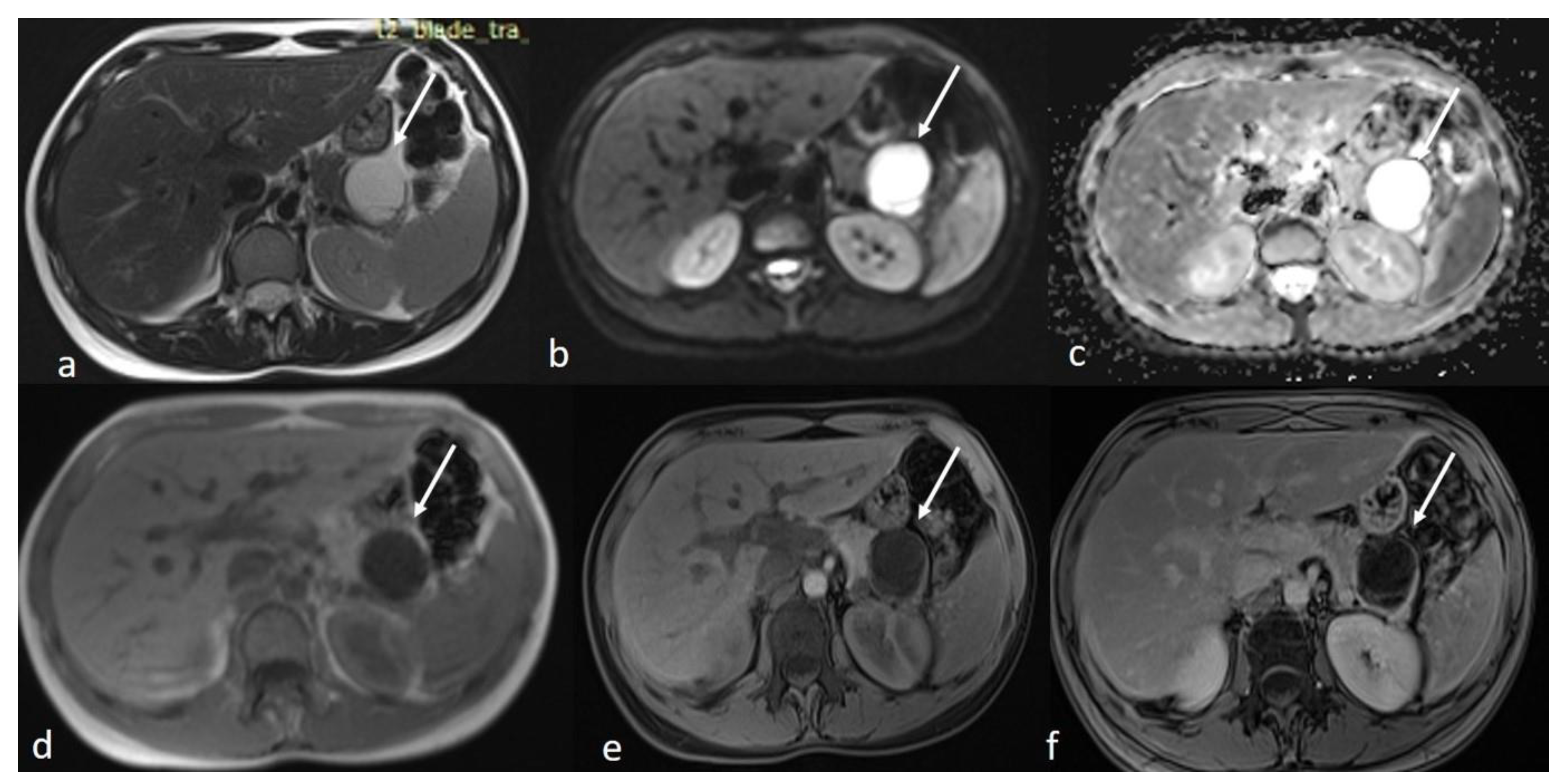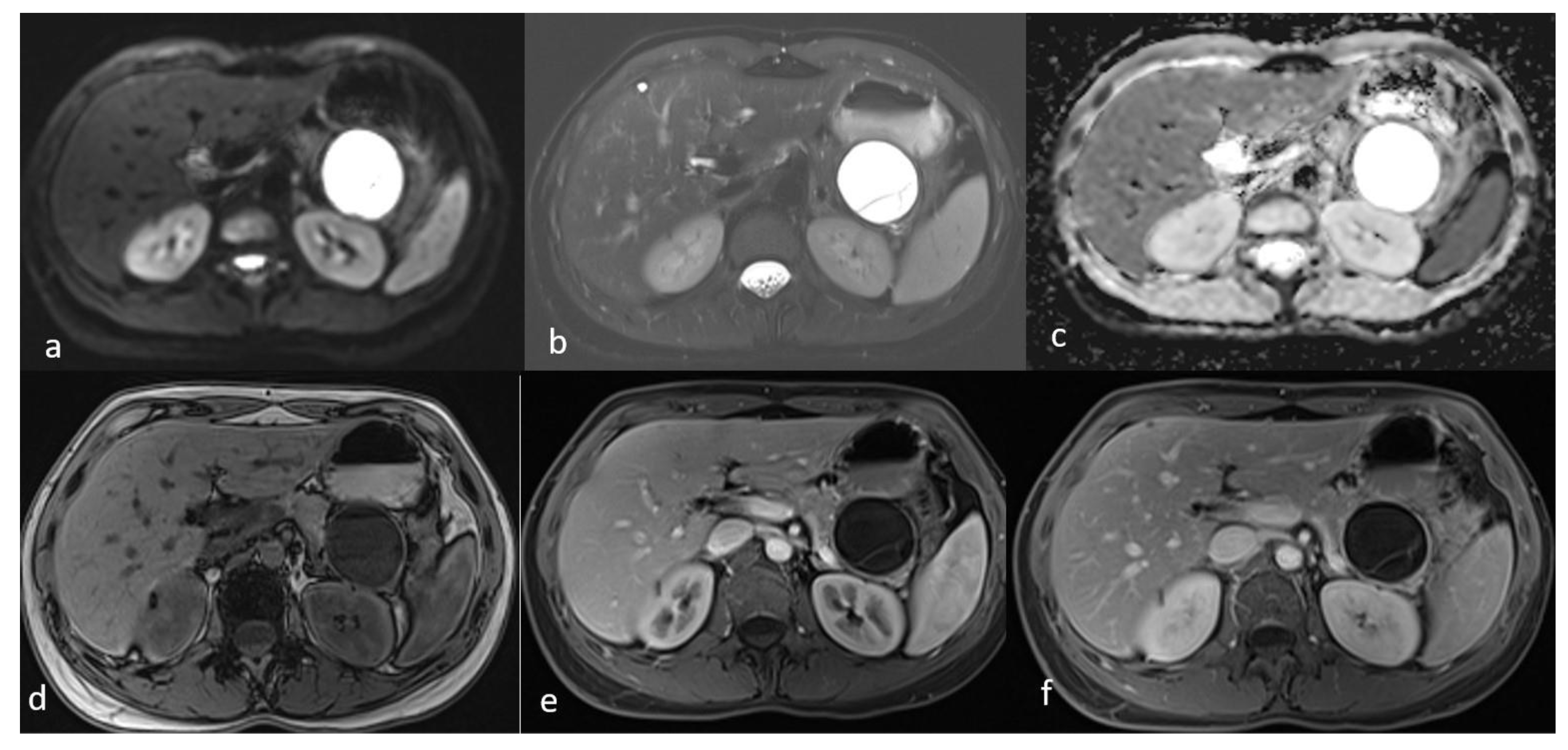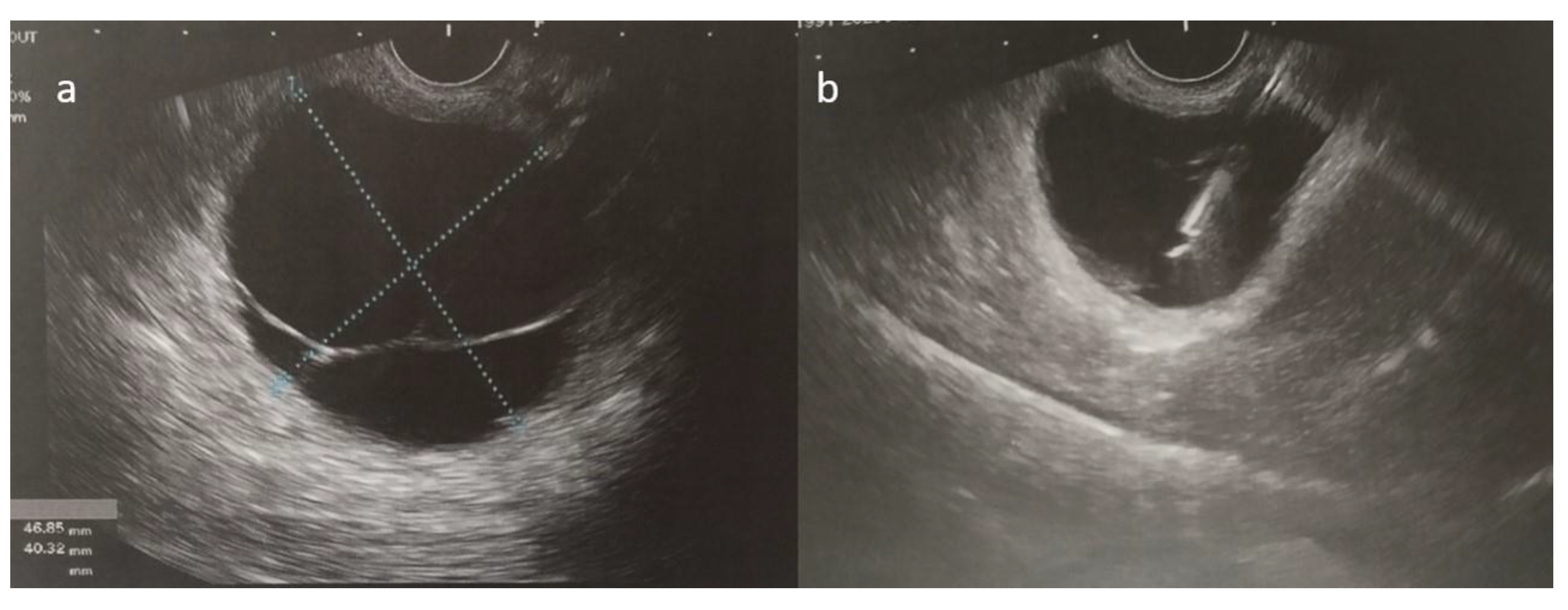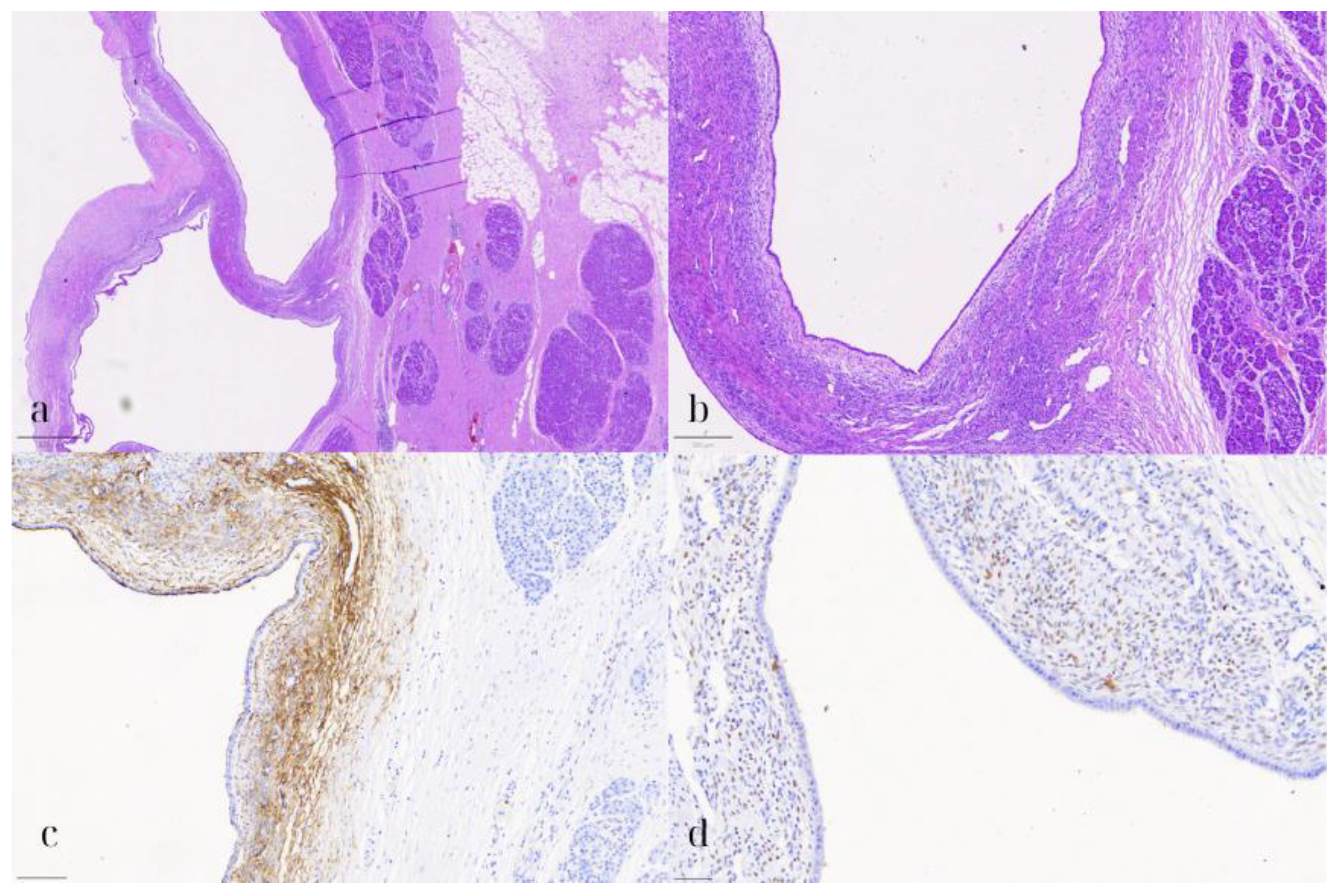Pancreatic Endometriosis Coexisting with a Splenic Mesothelial Cyst: A Rare Case Report and Review of the Literature
Abstract
1. Introduction
2. Case Report
2.1. Imaging Findings
2.2. Surgical Procedure and Postoperative Course
2.3. Pathological Findings
3. Discussion
4. Conclusions
Author Contributions
Funding
Institutional Review Board Statement
Informed Consent Statement
Data Availability Statement
Conflicts of Interest
References
- Taylor, H.S.; Kotlyar, A.M.; Flores, V.A. Endometriosis is a chronic systemic disease: Clinical challenges and novel innovations. Lancet 2021, 397, 839–852. [Google Scholar] [CrossRef] [PubMed]
- Andres, M.P.; Arcoverde, F.V.; Souza, C.C.; Fernandes, L.F.C.; Abrão, M.S.; Kho, R.M. Extrapelvic Endometriosis: A Systematic Review. J. Minim. Invasive Gynecol. 2020, 27, 373–389. [Google Scholar] [CrossRef] [PubMed]
- Huang, B.; Mooser, A.; Carpenter, D.; Montenegro, G.; Luu, C. A Rare Case of Pancreatic Endometriosis Masquerading as Pancreatic Mucinous Neoplasm. Case Rep. Surg. 2021, 2021, 5570290. [Google Scholar] [CrossRef] [PubMed]
- Gkegkes, I.D.; Fotiou, A.; Mavroeidis, V.K.; Gerogiannis, I.N.; Iavazzo, C. Pancreatic endometriosis: A systematic review. Ann. Gastroenterol. 2023, 36, 61–67. [Google Scholar] [CrossRef] [PubMed] [PubMed Central]
- Vijayaraghavan, R.; Chandrashekar, R.; Aithal, S.; Rashmi, M.V.; Belagavi, C.S. Mesothelial cyst of the spleen in an adult: A case report. BMJ Case Rep. 2010, 2010, bcr0320102810. [Google Scholar] [CrossRef]
- Park, M.; Lee, J.; Kim, Y.; Choi, C.-H.; Park, K.S. Mesothelial cyst of the spleen mimicking a metastasis: A case report. J. Int. Med. Res. 2021, 49, 3000605211031736. [Google Scholar] [CrossRef]
- Yamamoto, R.; Konagaya, K.; Iijima, H.; Kashiwagi, H.; Hashimoto, M.; Shindo, A.; Sasaki, Y.; Yamamoto, K.; Nakagawa, M.; Suno, Y.; et al. A Rare Case of Pancreatic Endometrial Cyst and Review of the Literature. Intern. Med. 2019, 58, 1097–1101. [Google Scholar] [CrossRef]
- Oishi, M.; Hashida, H.; Yuba, Y.; Takabayashi, A. Pancreatic endometrial cyst: Report of a case. Surg. Today 2011, 41, 1011–1015. [Google Scholar] [CrossRef]
- AlNuaimi, D.; Akmal, Y.; AlDuaij, A.; Sherif, A.; Abdulghaffar, S.; Balci, N.C. Pancreatic endometrioma: A rare differential diagnosis for a pseudocyst. BJR Case Rep. 2023, 9, 20220141. [Google Scholar] [CrossRef]
- Assifi, M.M.; Nguyen, P.D.; Agrawal, N.; Dedania, N.; Kennedy, E.P.; Sauter, P.K.; Prestipino, A.; Winter, J.M.; Yeo, C.J.; Lavu, H. Non-neoplastic Epithelial Cysts of the Pancreas: A Rare, Benign Entity. J. Gastrointest. Surg. 2014, 18, 523–531. [Google Scholar] [CrossRef]
- Veeraswamy, A.; Lewis, M.; Mann, A.; Kotikela, S.; Hajhosseini, B.; Nezhat, C. Extragenital Endometriosis. Clin. Obstet. Gynecol. 2010, 53, 449–466. [Google Scholar] [CrossRef] [PubMed]
- Daga, G.; Mittal, V.; Singh, R.; Sood, N. Epithelial cyst of the spleen. J. Indian Assoc. Pediatr. Surg. 2011, 16, 18–20. [Google Scholar] [CrossRef] [PubMed]
- Elosua González, A.; Nantes Castillejo, O.; Tarifa Castilla, A.; Llanos Chávarri, M.C. Quiste mesotelial primario esplénico como causa infrecuente de dispepsia: A propósito de un caso. Rev. Gastroenterol. Mex. 2018, 83, 463–465. [Google Scholar] [CrossRef]
- Zondervan, K.T.; Becker, C.M.; Missmer, S.A.; Longo, D.L. Endometriosis. N. Engl. J. Med. 2020, 382, 1244–1256. [Google Scholar] [CrossRef] [PubMed]
- Kurisu, Y.; Tsuji, M.; Shibayama, Y.; Yamada, T.; Ohmichi, M. Multicystic Mesothelioma Caused by Endometriosis. Int. J. Gynecol. Pathol. 2011, 30, 163–166. [Google Scholar] [CrossRef]
- McCluggage, W.G. Endometriosis-related pathology: A discussion of selected uncommon benign, premalignant and malignant lesions. Histopathology 2020, 76, 76–92. [Google Scholar] [CrossRef]
- Elta, G.H.; Enestvedt, B.K.; Sauer, B.G.; Lennon, A.M. ACG Clinical Guideline: Diagnosis and Management of Pancreatic Cysts. Am. J. Gastroenterol. 2018, 113, 464–479. [Google Scholar] [CrossRef]
- Tunuguntla, A.; Van Buren, N.; Mathews, M.R.; Ehrenfried, J.A. Endometriosis of the Pancreas Presenting as a Cystic Pancreatic Neoplasm with Possible Metastasis. South. Med. J. 2004, 97, 1020–1021. [Google Scholar] [CrossRef]
- Marchevsky, A.M.; Zimmerman, M.J.; Aufses, A.H.; Weiss, H. Endometrial Cyst of the Pancreas. Gastroenterology 1984, 86, 1589–1591. [Google Scholar] [CrossRef]
- Goswami, A.K.; Sharma, S.K.; Tandon, S.P.; Malik, N.; Mathur, R.P.; Malik, A.K.; Bapna, B.C. Pancreatic Endometriosis Presenting as a Hypovascular Renal Mass. J. Urol. 1986, 135, 112–113. [Google Scholar] [CrossRef]
- Gutiérrez, C.D.; Muñoz, B.R. Pancreatic endometriosis a rare entity in surgery: A case report. Int. Surg. J. 2024, 11, 819–821. [Google Scholar] [CrossRef]
- Ludwig, C.; Kopacz, A.; Warren, M.L.; Onkendi, E. Symptomatic pancreatic body endometrial cyst requiring en bloc distal pancreatectomy. BMJ Case Rep. 2021, 14, e244911. [Google Scholar] [CrossRef] [PubMed]
- Karaosmanoglu, A.D.; Arslan, S.; Ozbay, Y.; Sokmensuer, C.; Ozogul, E.; Karcaaltincaba, M. Pancreatic Endometrioma Presenting With Spontaneous Hemorrhagic Rupture. Pancreas 2020, 49, e23–e24. [Google Scholar] [CrossRef]
- Verbeke, C.; Härle, M.; Sturm, J. Cystic Endometriosis of the Upper Abdominal Organs. Pathol. Res. Pract. 1996, 192, 300–304. [Google Scholar] [CrossRef] [PubMed]
- Mederos, M.A.; Villafañe, N.; Dhingra, S.; Farinas, C.; McElhany, A.; Fisher, W.E.; Ii, G.V.B. Pancreatic endometrial cyst mimics mucinous cystic neoplasm of the pancreas. World J. Gastroenterol. 2017, 23, 1113–1118. [Google Scholar] [CrossRef] [PubMed]
- Lee, D.S.; Baek, J.T.; Ahn, B.M.; Lee, E.H.; Han, S.W.; Chung, I.S.; Sun, H.S.; Park, D.H. A case of pancreatic endometrial cyst. Korean J. Intern. Med. 2002, 17, 266–269. [Google Scholar] [CrossRef]
- Plodeck, V.; Sommer, U.; Baretton, G.B.; E Aust, D.; Laniado, M.; Hoffmann, R.-T.; Platzek, I. A rare case of pancreatic endometriosis in a postmenopausal woman and review of the literature. Acta Radiol. Open 2016, 5, 2058460116669385. [Google Scholar] [CrossRef]
- Monrad-Hansen, P.W.; Buanes, T.; Young, V.S.; Langebrekke, A.; Qvigstad, E. Endometriosis of the Pancreas. J. Minim. Invasive Gynecol. 2012, 19, 521–523. [Google Scholar] [CrossRef]







| Study ID | Patient Demographics (Age) | Clinical Presentation | Emergency Presentation | Menstrual History | Anatomic Location | Diameter (cm) | Preoperative Diagnosis | Treatment | Postoperative Course |
|---|---|---|---|---|---|---|---|---|---|
| Marchevsky et al., 1984 [19] | 36 | Epigastric pain radiating to back | No | Normal | Tail | 4.5 | Endometriosis | Distal PE and SE, and cholecystectomy | Uneventful |
| Goswami et al., 1985 [20] | 40 | Left flank pain | No | Normal | Tail | 8 | Malignant lesion | Distal PE and SE along with left radical nephrectomy | - |
| Verbeke et al., 1996 [24] | 28 | Epigastric pain | No | Pain correlated with menstrual cycle | Body and Tail | 4 | Postinflammatory pseudocyst | PE and SE | Uneventful |
| Lee et al., 2002 [26] | 21 | Epigastric pain Weight loss | No | Normal | Body | 4 | Mucinous cystic adenoma | Partial PE | Uneventful |
| Tunuguntla et al., 2004 [18] | 34 | Acute epigastric pain | Yes | Normal | Tail | 8 | Suspected cystic neoplasm | Distal PE and SE | Uneventful |
| Oishi et al., 2011 [8] | 35 | Epigastric pain radiating to back and chest | No | Pain correlated with menstrual cycle | Body | 4 | Mucinous cystic adenoma | Distal PE and SE | Severe pain on postoperative day 1 |
| Monrad-Hansen et al., 2012 [28] | 43 | Acute epigastric pain | Yes | Irregular cycle | - | - | Suspected endometriosis and carcinomatosis | Explorative laparoscopy, left oophorectomy, drainage of cyst. | Uneventful |
| Assifi et al., 2014 [10] | 32 | Abdominal pain | - | - | Tail | - | - | Distal PE and SE | - |
| 63 | None | - | - | Body | - | - | Distal PE and SE | - | |
| Plodeck et al., 2016 [27] | 72 | Abdominal pain | No | Hysterectomy | Tail | 2.2 | Mucinous cystic adenoma | Left hemipancreatectomy | Minor respiratory issues |
| Mederos et al., 2017 [25] | 43 | Abdominal pain, fatigue, diarrhea, anorexia, weight loss | No | Normal | Body and Tail | 16 | Premalignant pancreatic cystic lesion | Laparoscopic distal PE and SE | Uneventful |
| Yamamoto et al., 2018 [7] | 26 | Acute epigastric pain | Yes | Irregular cycle | Body | 7 | Mucinous cystic adenoma | Laparoscopic distal PE and SE | Uneventful |
| Karaosmanoglu et al., 2020 [23] | 38 | Acute epigastric pain | Yes | Normal | Tail | 10 | Complicated acute pancreatitis or ruptured mucinous cystic adenoma | Distal PE, subtotal distal GE, and SE | Uneventful |
| Huang et al., 2021 [3] | 51 | Epigastric pain radiating to back, diarrhea with greasy stools, and anorexia without weight loss | No | Hysterectomy | Body and Tail | 3.7 | IPMN | Robotic distal PE and splenectomy | Uneventful |
| Ludwig et al., 2021 [22] | Early 30s | Acute abdominal pain | Yes | Appendiceal endometriosis | Body | 11 | Mesenteric duplication cyst, pancreatic pseudocyst, and endometrioma | Robotic potentially pancreas-sparing cyst resection with possible cystogastrostomy | Recurrent epigastric pain |
| AlNuaimi et al., 2023 [9] | 31 | Epigastric pain, nausea, vomiting | Yes | Normal | Tail | 3 | Mucinous cystic adenoma | Distal subtotal robotic PE | Uneventful |
| Gutiérrez et al., 2024 [21] | 29 | Epigastric pain, nausea, vomiting, dysphagia, and weight loss | Yes | Normal | Body | 15 | Malignant or premalignant lesion | Exploratory laparotomy | Uneventful |
| Study ID | CT | MRI | Laboratory |
|---|---|---|---|
| Marchevsky et al., 1984 [19] | Cystic mass in the tail of the pancreas. | - | Elevated amylase |
| Goswami et al., 1985 [20] | - | - | - |
| Verbeke et al., 1996 [24] | - | - | Normal |
| Lee et al., 2002 [26] | Oval-shaped low-density cystic mass in the pancreatic body with bulging-out contour, distinct capsular enhancement, and suspicious internal septations. | - | Normal (CA 19-9 mildly elevated) |
| Tunuguntla et al., 2004 [18] | Cystic mass in the tail of the pancreas abutting the spleen. Follow-up CT showed reaccumulation of the cystic collection. | - | Elevated amylase |
| Oishi et al., 2011 [8] | Cystic lesion in pancreatic body. | Multilocular cyst with septal wall, no ductal dilatation or stenosis. | Normal |
| Monrad-Hansen et al., 2012 [28] | Peripancreatic swelling, tissue changes around the pancreas and mesentery | Hyperintense T1 and hypointense T2 signals around pancreas, consistent with blood products, no diffusion restriction or contrast enhancement. | Normal |
| Plodeck et al., 2016 [27] | Partly cystic, partly solid lesion in pancreatic tail with small calcification. | Partially cystic, partially hemorrhagic lesion with subtle rim enhancement, pancreatic tail hypotrophy. | Elevated GGT, ALAT, CRP |
| Mederos et al., 2017 [25] | Macrocystic, well-circumscribed mass with internal septations, no nodules or internal enhancement. | - | Elevated cystic CEA |
| Yamamoto et al., 2018 [7] | Cystic lesion in pancreatic body. | Cystic lesion, no ductal dilatation, stenosis, or displacement. | Elevated WBC |
| Karaosmanoglu et al., 2020 [23] | Cystic mass with thick walls, mural papillary nodules, invading splenic parenchyma. | Confirmed CT findings, subcapsular fluid collection. | Elevated pancreatic amylase |
| Huang et al., 2021 [3] | - | Cystic lesion in the pancreatic body, consistent with IPMN, no main duct dilation or nodules. | Normal |
| Ludwig et al., 2021 [22] | Simple cystic mass in the left upper abdomen, medial to the lesser curvature of the stomach, inseparable from the anterior aspect of the pancreas. | Confirmed cyst with mass effect on pancreas and stomach. | - |
| AlNuaimi et al., 2023 [9] | Unilocular cyst in pancreatic tail, slight atrophy of the distal tail, no signs of acute pancreatitis. | Hypointense on T1, hyperintense on T2, minimal wall contrast enhancement, no diffusion restriction. | Elevated CEA and amylase |
| Gutiérrez et al., 2024 [21] | Poorly evaluable nodular appearance of the pancreatic gland. Cyst-like lesion in the body of the pancreas. | - | Normal |
| Study ID | Gross Surgical Findings | Microscopic Findings | Immunohistochemistry |
|---|---|---|---|
| Marchevsky et al., 1984 [19] | Cyst, well-circumscribed, with a smooth, trabeculated, gray-brown wall and areas of hemorrhage. | Lined by fibrous tissue with endometrial glands (cuboidal and columnar cells) and a well-vascularized spindle cell stroma, hemosiderin deposition, and focal hemorrhage | - |
| Goswami et al., 1985 [20] | Compressed the posteroinferior aspect of the kidney, inner surface of the cyst smooth and dark brown in color. Compressed kidney was small and atrophic. Another smaller cyst compressing the pancreas with fibrotic tail. | Pancreatic tissue showed typical endometrial glands and stroma. Pancreatic and peripancreatic tissue showed considerable fibrosis and hemosiderin accumulation. Thick fibrous wall with numerous macrophages and abundant hemosiderin pigment, suggesting an endometrial cyst. Pyelitis and focal tubulointerstitial nephritis noted | - |
| Verbeke et al., 1996 [24] | Tumor with multiple cysts, walls of cysts grayish-white, smooth, brown-spotted surface. | Endometrial-type stroma, spindle cells, hemorrhage, hemosiderin-laden macrophages, varied epithelial cell types, slight fibrosis in pancreatic tissue | Positive for pancytokeratin, CA19-9; weak expression of CA125; negative for ER, PR, vimentin. |
| Lee et al. 2002 [26] | Well-circumscribed cyst in pancreatic stroma, gray-brown wall with focal hemorrhage. | Endometrial glands with spindle cell stroma, focal hemorrhage, and hemosiderin-laden macrophages | Positive for ER and nuclear PR. |
| Tunuguntla et al., 2004 [18] | Cyst in the tail of the pancreas; suspicious lesions on the right diaphragm and liver, and potential neoplastic areas on the spleen. | Atypical glandular structure | - |
| Oishi et al., 2011 [8] | Cyst, irregular inner surface, brownish-yellow and reddish-brown color, no pancreatic duct fistula. | Thick fibrous wall, endometrial glands with spindle cell stroma, focal hemorrhage, hemosiderin deposition | Positive for CD10, PR, negative for ER. |
| Monrad-Hansen et al., 2012 [28] | Cystic structure with liquified gray material (old, resorbed blood). | Peripancreatic fatty tissue with focal fibrosis, hemosiderin-laden macrophages | Stromal cells positive for CD10, indicative of endometriosis. |
| Plodeck et al., 2016 [27] | Multicystic lesion with hemorrhage and fibrosis. | Cysts lined with flat to cubic epithelium, ovarian-type stroma, significant hemorrhage, and dystrophic calcification | Smooth muscle cells visible, part of endometrial stroma. |
| Mederos et al., 2017 [25] | Unilocular cyst, gray-green cloudy fluid, smooth trabeculated gray-brown wall, focal hemorrhage. | Benign cubo-columnar epithelial lining, bland spindle cells, thin-walled blood vessels, hemosiderin-laden macrophages | Positive for CD10 and ER, negative for inhibin. |
| Yamamoto et al., 2018 [7] | Cyst with smooth, trabeculated gray-brown wall, focal hemorrhage. | Elongated endometrial glands with spindle cell stroma, areas of focal hemorrhage, hemosiderin-laden macrophages | Positive for CD10, ER, and PR; negative for inhibin. |
| Karaosmanoglu et al., 2020 [23] | Hemorrhagic cystic lesion with mural discontinuity, no clear separation between pancreatic tail and splenic hilum. | Glandular structures in endometrial background | Positive for ER in stromal cells. |
| Huang et al., 2021 [3] | Endometriotic cyst. | Endometrial stroma with hemosiderin-laden macrophages; no mucinous epithelium or ovarian-type stroma | - |
| Ludwig et al., 2021 [22] | Fibrinopurulent exudate, granulation tissue, fibrotic scar with eosinophils and plasma cells, indicating cyst infection and abscess. | Confirmed cyst with mass effect on pancreas and stomach | CD10 staining for endometrial stroma in the initial cyst. |
| AlNuaimi et al., 2023 [9] | Unilocular cyst lined by tall, non-mucin-producing cells with ovarian-type stromal component, inflammatory infiltrate, hemosiderin-laden macrophages. | Non-mucinous columnar cells, ovarian-type stroma, foamy histiocytes with hemosiderin | Positive for CD10, ER, CK-7, and CK-19. |
| Gutiérrez et al., 2024 [21] | Macroscopically identified as an endometrioma. Cystic liquid sampled for analysis. | Loose connective tissue and fibrosis zones with venules and mononuclear inflammatory cell infiltrate, including gold pigmentation attached to fibrous connective tissue, in addition to phagocytosis of hemosiderin by macrophage | - |
Disclaimer/Publisher’s Note: The statements, opinions and data contained in all publications are solely those of the individual author(s) and contributor(s) and not of MDPI and/or the editor(s). MDPI and/or the editor(s) disclaim responsibility for any injury to people or property resulting from any ideas, methods, instructions or products referred to in the content. |
© 2025 by the authors. Licensee MDPI, Basel, Switzerland. This article is an open access article distributed under the terms and conditions of the Creative Commons Attribution (CC BY) license (https://creativecommons.org/licenses/by/4.0/).
Share and Cite
Paramythiotis, D.; Syrnioti, A.; Tsavdaris, D.; Smprini, A.; Mekras, A.; Apostolidis, A.; Cheva, A. Pancreatic Endometriosis Coexisting with a Splenic Mesothelial Cyst: A Rare Case Report and Review of the Literature. Diseases 2025, 13, 203. https://doi.org/10.3390/diseases13070203
Paramythiotis D, Syrnioti A, Tsavdaris D, Smprini A, Mekras A, Apostolidis A, Cheva A. Pancreatic Endometriosis Coexisting with a Splenic Mesothelial Cyst: A Rare Case Report and Review of the Literature. Diseases. 2025; 13(7):203. https://doi.org/10.3390/diseases13070203
Chicago/Turabian StyleParamythiotis, Daniel, Antonia Syrnioti, Dimitrios Tsavdaris, Aikaterini Smprini, Alexandros Mekras, Athanasios Apostolidis, and Angeliki Cheva. 2025. "Pancreatic Endometriosis Coexisting with a Splenic Mesothelial Cyst: A Rare Case Report and Review of the Literature" Diseases 13, no. 7: 203. https://doi.org/10.3390/diseases13070203
APA StyleParamythiotis, D., Syrnioti, A., Tsavdaris, D., Smprini, A., Mekras, A., Apostolidis, A., & Cheva, A. (2025). Pancreatic Endometriosis Coexisting with a Splenic Mesothelial Cyst: A Rare Case Report and Review of the Literature. Diseases, 13(7), 203. https://doi.org/10.3390/diseases13070203







